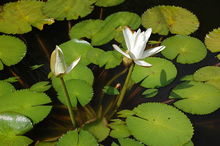- Nymphaeales
-
Nymphaeales
Temporal range: 130–0 Ma Early Cretaceous - Recent
Nymphaea lotus Scientific classification Kingdom: Plantae (unranked): Angiosperms Order: Nymphaeales
Salisb. ex Bercht. & J.PreslFamilies Nymphaeales is an order of plants, which consists of water lilies and other aquatic plants.
This order is considered to be a basal, or early diverging, group of angiosperms. The families of this order are united by being families of aquatic herbs and are known from the fossil record as early as the Lower Cretaceous.
Fossils
The fossil record consists especially of seeds, and also pollen, stems, leaves, and flowers. It extends back to the Cretaceous.[1][2]
It is possible that the aquatic plant fossil Archaefructus belongs to this group.[3]
Classification
The Nymphaeales currently includes three families and about 65 to 80 species.
order Nymphaeales - Cabombaceae
- Hydatellaceae
- Trithuria (7 species)
- Nymphaeaceae
Angiospermae Nymphaeales Chloranthales
monocots
The classification of Nymphaeales and phylogeny within the flowering plants, as of APG III (2009). This order was not part of the APG II system's 2003 plant classification (unchanged from the APG system of 1998), which instead had a broadly circumscribed family Nymphaeaceae (including Cabombaceae) unplaced in any order. The APG III system did separate Cabombaceae from Nymphaeaceae and place them in the order Nymphaeales together with Hydatellaceae. This Hydatellaceae was placed among the monocots in previous systems, but a 2007 study found that the family belongs to this group.[4]
Some earlier systems, such as Cronquist's system of 1981, often included the Ceratophyllaceae and Nelumbonaceae in the Nymphaeales. Although, the Takhtajan system of 1980 separated the Nelumbonales, the new order was retained alongside the Nymphaeales in the superorder Nymphaeanae.
The Cronquist system placed the Nymphaeales in subclass Magnoliidae, in class Magnoliopsida [=dicotyledons]. In addition, Cronquist included the Ceratophyllaceae and split the family Barclayaceae from the Nymphaeaceae. Under the APG II system, the family Cambombaceae was included within the Nymphaeaceae, but could optionally be recognized separately. As of APG III, the two families are recognized separately.
The Dahlgren system placed Nymphaeales together with the Piperales in superorder Nymphaeanae, within subclass Magnoliideae (dicotyledons). Thorne's 1992 system (and 2000 revision) placed Nymphaeales as the sole order in the superorder Nymphaeanae within subclass Magnoliideae (=dicotyledons).
Comparison of the Nymphaeales across five systems APG III system[5]
NymphaealesTakhtajan system[6]
NymphaealesCronquist system[7]
NymphaealesDahlgren system[8]
NymphaealesThorne system (1992)[9] & (2000)[10]
NymphaealesHydatellaceae among monocots, as Hydatellales Cabombaceae Cabombaceae - Brasenia, Cabomba
Cabombaceae - Brasenia, Cabomba
Cabombaceae Cabombaceae - Brasenia, Cabomba
Nymphaeaceae Nymphaeaceae - subf. Barclayoideae, Euryaloideae, Nymphaeoideae
Barclayaceae - Barclaya
Nymphaeaceae Nymphaeaceae - Barclaya, Euryale, Nuphar, Nymphaea, Ondinea, Victoria
Nymphaeaceae - Euryale, Nuphar, Nymphaea, Ondinea, Victoria
sister to eudicot clade Ceratophyllaceae Ceratophyllaceae Ceratophyllaceae in Ranunculanae placed in eudicot clade in Nelumbonales Nelumbonaceae in Magnolianae References
- ^ "Nymphaeales: Fossil Record". University of California Museum of Paleontology. http://www.ucmp.berkeley.edu/anthophyta/paleoherbs/nymphfr.html.
- ^ Else Marie Friis, Kaj Raunsgaard Pedersen and Peter R. Crane (15 March 2001). "Fossil evidence of water lilies (Nymphaeales) in the Early Cretaceous". Nature 410 (6826): 357–360. doi:10.1038/35066557. PMID 11268209.
- ^ Soltis, D. E.; Bell, CD; Kim, S; Soltis, PS (published June 2008). "The Year in Evolutionary Biology 2008". Ann. N.Y. Acad. Sci. 1133 (1): 3–25. doi:10.1196/annals.1438.005. PMID 18559813. http://www.annalsnyas.org/cgi/content/abstract/1133/1/3.
- ^ Saarela et al; Rai, HS; Doyle, JA; Endress, PK; Mathews, S; Marchant, AD; Briggs, BG; Graham, SW (2007). "Hydatellaceae identified as a new branch near the base of the angiosperm phylogenetic tree". Nature 446 (7133): 312–5. doi:10.1038/nature05612. PMID 17361182.
- ^ Angiosperm Phylogeny Group (2009). "An update of the Angiosperm Phylogeny Group classification for the orders and families of flowering plants: APG III". Botanical Journal of the Linnean Society 161 (2): 105–121. doi:10.1111/j.1095-8339.2009.00996.x.
- ^ Takhtajan, Armen L. (1980). "Outline of the classification of flowering plants (Magnoliophyta)". The Botanical Review 46 (3): 225–359. doi:10.1007/BF02861558.
- ^ Cronquist, Arthur (1981). An Integrated System of Classification of Flowering Plants. New York: Columbia Univ. Press. ISBN 0-231-03880-1.
- ^ Dahlgren, R.M.T. (1980). "A revised system of classification of angiosperms". Botanical Journal of the Linnean Society 80 (2): 91–124. doi:10.1111/j.1095-8339.1980.tb01661.x.
- ^ Thorne, R. F. (1992). "Classification and geography of the flowering plants". Botanical Review 58 (3): 225–348. doi:10.1007/BF02858611.
- ^ Thorne, R. F. (2000). "The classification and geography of the flowering plants: Dicotyledons of the class Angiospermae". Botanical Review 66 (4): 441–647. doi:10.1007/BF02869011.
- Simpson, M.G. Plant Systematics. Elsevier Academic Press. 2006.
Categories:- Angiosperm orders
Wikimedia Foundation. 2010.
